Panasonic NN-ST65JWQPQ, NN-ST67JSQPQ, NN-ST69JSQPQ User Manual
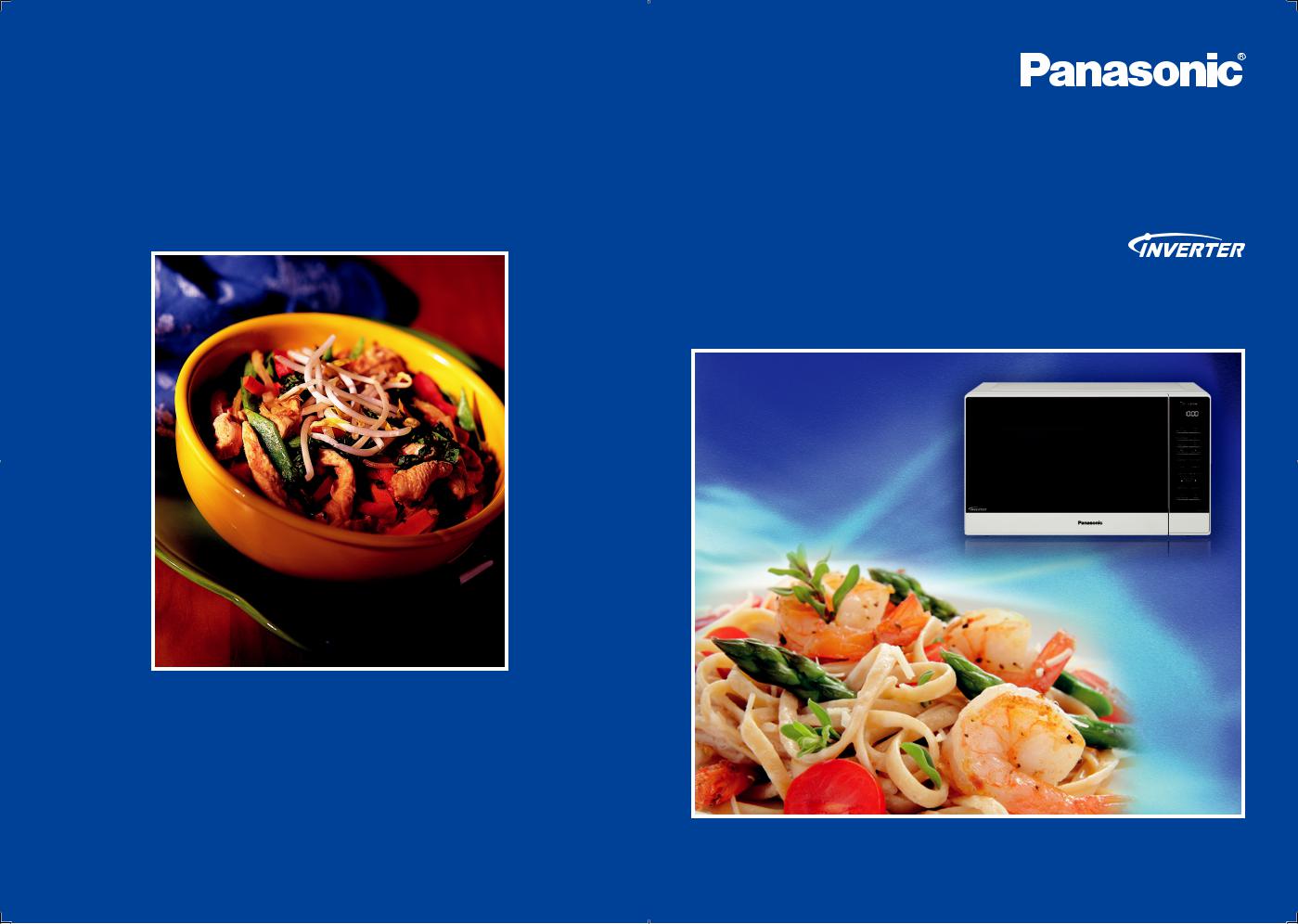
© Panasonic Appliances Microwave Oven (Shanghai) Co., Ltd. 2018
F0003CA01QP
PA0718-10718
Printed in China
Operating Instruction and Cook Book
Microwave Oven
Household Use Only
Model No. NN-ST65JW
NN-ST67JS
NN-ST69JS
NN-ST65JW
Please read these instructions carefully before using this product, and save this manual for future use.
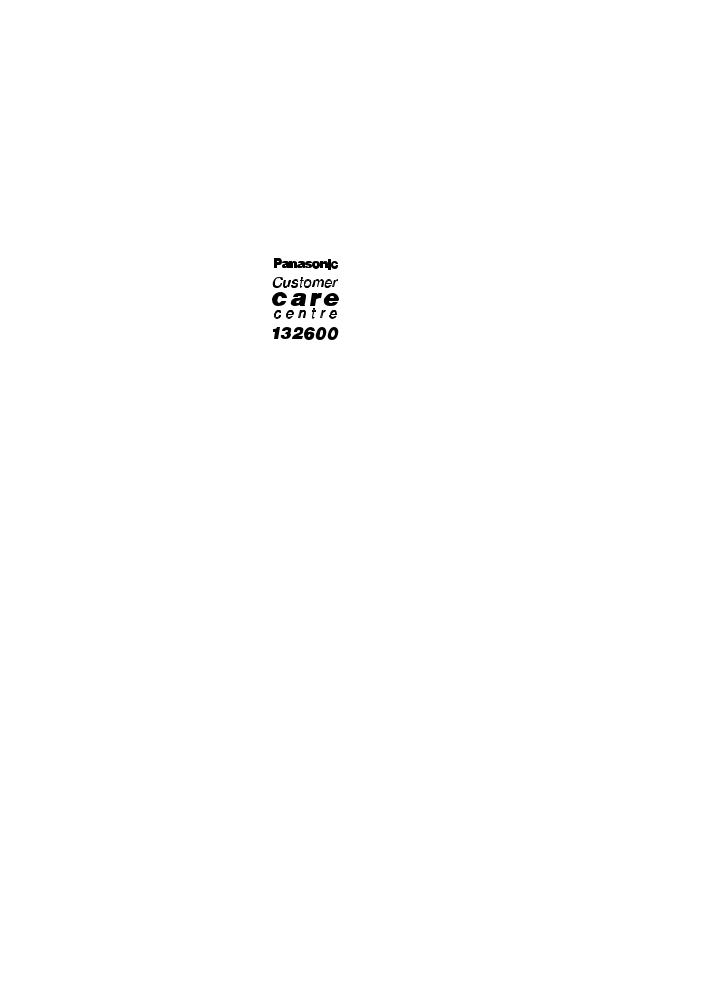
We are glad you have chosen to purchase a PANASONIC microwave oven. Before operating this oven, please read these instructions carefully and completely, and keep them for further reference.
If you have only used a microwave oven for reheating and defrosting, with Panasonic’s Inverter Technology you can be reassured of excellent results when cooking a variety of foods, as the ‘soft’ penetration of microwave energy to the centre of food helps prevent over cooking on edges and surfaces. Foods can now be gently simmered without the concern of boil over.
After reading the introductory chapter, we are sure you will be able to master the basic techniques and thereby develop a firm understanding of your new oven. This book includes recipes from starters to desserts. After trying our recipes be sure to adapt your favourite recipes to microwave methods.
Start experimenting now, and enjoy the first class results you will achieve by using your new microwave oven.
Panasonic Australia Pty Ltd |
Panasonic NZ Ltd |
|
|
1 Innovation Road |
Customer Care Centre |
|
|
Macquarie Park |
18 Sir Woolf Fisher Drive |
|
|
NSW 2113 |
Highbrook, Auckland |
Phone: (09) |
272 0178 |
|
Private Bag 14911 |
||
|
Panmure, Auckland |
Fax: (09) |
272 0129 |
The serial number of this product may be found on |
MODEL NUMBER _______________________ |
the back side of the oven. You should note the model |
|
number and serial number of this oven in the space |
SERIAL NUMBER _______________________ |
provided and retain this book as a permanent record |
DATE OF PURCHASE ____________________ |
of your purchase for future reference. |

Table of Contents |
|
Before Operation |
|
Important Safety Instructions....................................................................................................... |
6-7 |
Installation and General Instructions........................................................................................... |
7-8 |
Microwaves and How They Work................................................................................................... |
9 |
Cookware and Utensils Guide................................................................................................... |
9-10 |
Feature Diagram .......................................................................................................................... |
11 |
Control Panel................................................................................................................................ |
12 |
Ingredient Conversion Chart ........................................................................................................ |
26 |
Operation and Hints |
|
Quick Guide to Operation............................................................................................................ |
4-5 |
Let's Start To Use Your Oven! ...................................................................................................... |
13 |
Display Window............................................................................................................................ |
13 |
To Set Clock ................................................................................................................................. |
14 |
To Use Child Safety Lock ............................................................................................................. |
14 |
To Cook on Micro Power by Time Setting .................................................................................... |
15 |
To Defrost on Micro Power by Time Setting ................................................................................. |
16 |
To Defrost using Turbo Defrost................................................................................................ |
16-17 |
To Cook using the Quick 30 Feature ............................................................................................ |
18 |
Using the Add Time Feature......................................................................................................... |
18 |
To Use Sensor Reheat Feature.................................................................................................... |
19 |
To use Beverage Feature ............................................................................................................. |
20 |
To Use Sensor Cook Menus.................................................................................................... |
21-24 |
To Use Melt & Soften Feature ...................................................................................................... |
25 |
3-Stages Setting........................................................................................................................... |
26 |
To Use Timer ................................................................................................................................ |
27 |
Defrosting Chart ........................................................................................................................... |
28 |
Reheating Chart ........................................................................................................................... |
29 |
Cooking Chart .............................................................................................................................. |
30 |
Maintenance |
|
Before Requesting Service........................................................................................................... |
31 |
Care of Your Microwave Oven...................................................................................................... |
32 |
Technical Specifications ............................................................................................................... |
33 |
Panasonic Warranty ................................................................................................................ |
34-35 |
Cooking Guide |
|
Microwave Recipe Techniques................................................................................................ |
36-38 |
Reheat..................................................................................................................................... |
39-41 |
Soups and Snacks. ................................................................................................................. |
42-43 |
Fish and Shellfish .................................................................................................................... |
44-45 |
Poultry and Eggs ..................................................................................................................... |
46-49 |
Main Fare Meats ..................................................................................................................... |
50-53 |
Vegetables and Legumes........................................................................................................ |
54-59 |
Rice, Pasta and Noodles......................................................................................................... |
60-63 |
Cakes, Desserts and Slices .................................................................................................... |
64-69 |
Sauces and Extras ....................................................................................................................... |
70 |
– 3 –
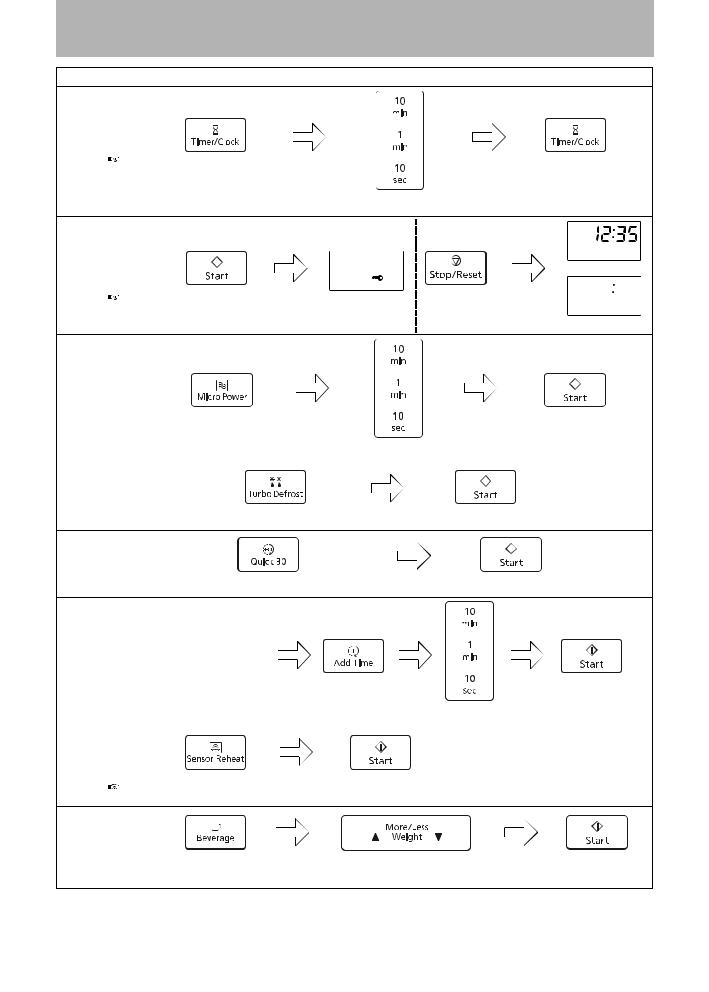
Quick Guide to Operation
Feature |
How to Operate |
To Set Clock |
|
|
|
|
|
|
|||
|
|
|
|
|
|||||
|
|
|
|
|
|||||
( |
page 14) |
|
|
|
|
||||
|
Press twice. |
Set time of day. (Max 12:59) |
Press once. |
||||||
|
To set |
|
To cancel |
|
|
||||
To Set/Cancel |
|
|
|
or |
|||||
Child Safety |
|
|
|
|
|
||||
|
|
|
|
||||||
Lock |
page 14) |
|
|
|
|
||||
( |
|
|
|
|
|||||
|
Press 3 times. |
Display. |
Press 3 times. |
|
Display. |
||||
To Cook/Defrost by on Micro Power by Time Setting
( page 15-16)
page 15-16)
To Use Turbo Defrost pad
( page 16)
page 16)
To Cook Using the Quick 30 pad
( page 18)
page 18)
To Use Add Time pad
( page 18)
page 18)
|
|
|
|
|
|
Select power. |
Select cooking time. |
|
|
Press once. |
|
|
|
|
|||
|
|
|
|
||
Press to select the desired weight. |
Press once. |
||||
|
|
|
|
|
|
|
|
|
|
|
|
Press to select the desired cooking time. |
Press once. |
At the end of program.
Press once. |
Set time. |
Press once. |
To Cook using Sensor Reheat pad
( page 19) Press once. |
Press once. |
To Cook using Beverage pad
( page 20)
page 20)
Press once. |
Select Serving/weight. |
Press once. |
– 4 –
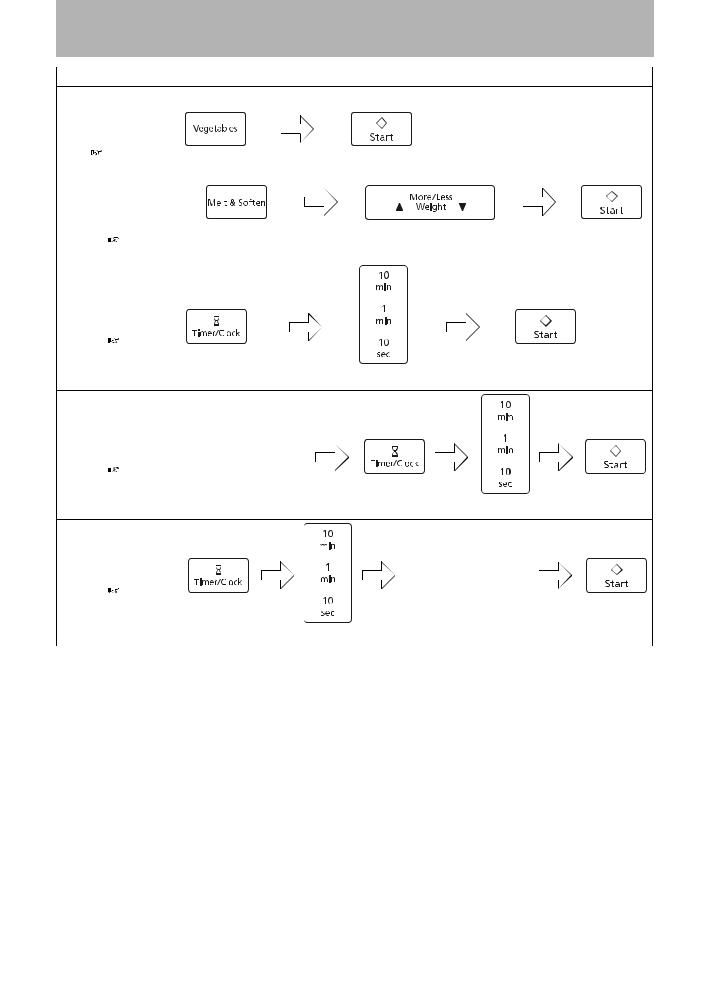
Quick Guide to Operation (continued)
Feature |
|
|
|
|
|
How to Operate |
|
|
|||
|
|
|
|
|
|
|
|
|
|||
To Cook using |
e.g. Frozen Vegetables. |
|
|
|
|
||||||
|
|
|
|
|
|
|
|
|
|||
Sensor Cook |
|
|
|
|
|
|
|
|
|
||
|
|
|
|
|
|
|
|
|
|||
pads |
|
|
|
|
|
|
|
|
|
|
|
( page 21-24) |
Press 3 times. |
Press once. |
|
|
|||||||
|
|
|
|
||||||||
To Cook using |
|
|
|
|
|
|
|
|
|
||
|
|
|
|
|
|
|
|
|
|||
Melt & Soften |
|
|
|
|
|
|
|
|
|
||
pad |
page 25) |
Press until desired |
Select Serving/weight. |
Press once. |
|||||||
( |
|||||||||||
menu number appears. |
|
|
|
|
|||||||
|
|
|
|
|
|
||||||
To Use Kitchen |
|
|
|
|
|
|
|
|
|
|
Timer |
page 27) |
|
|
|
|
|
|
|
|
|
|
|
|
|
|
|
|
|
|
||
( |
|
|
|
|
|
|
|
|
|
|
Press once. |
Set time. |
Press once. |
|
|
||||||
|
|
|
|
|||||||
To Set Standing |
Set the desired |
|
|
|
|
|
|
|||
Time |
|
cooking programme, |
|
|
|
|
||||
|
|
|
|
|
||||||
( |
page 27) |
up to 2 stages. |
|
|
|
|
|
|
||
|
|
|
|
|
|
|||||
|
|
(see page 26) |
|
|
|
|
|
|
||
|
|
|
|
|
Press once. |
Set time. |
Press once. |
|||
|
|
|
|
|
|
Set the desired |
|
|
||
To Set Delay Start |
|
|
|
|
cooking programme, |
|
|
|||
|
|
|
|
|
|
|||||
|
|
|
|
|
|
|||||
|
|
|
|
up to 2 stages. |
|
|
||||
( |
page 27) |
|
|
|
|
|
|
|||
|
|
|
|
|
(see page 26) |
|
|
|||
|
|
|
|
|
|
|
|
|
||
|
|
Press once. |
Set time. |
|
|
Press once. |
||||
– 5 –

Important Safety Instructions
READ CAREFULLY AND KEEP FOR FUTURE REFERENCE
Precautions To Be Taken When Using Microwave Ovens For Heating Foodstuffs
INSPECTION FOR DAMAGE:
A microwave oven should only be used if an inspection confirms all of the following conditions:
1.The door fits squarely and securely and opens and closes smoothly.
2.The door hinges are in good condition.
3.The metal plates of a metal seal on the door are neither buckled nor deformed.
4.The door seals are neither covered with food nor have large burn marks.
PRECAUTIONS:
Microwave radiation from microwave ovens can cause harmful effects if the following precautions are not taken:
1.Never tamper with or deactivate the interlocking devices on the door.
2.Never poke an object, particularly a metal object, through a grille or between the door and the oven while the oven is operating.
3.Never place saucepans, unopened cans or other heavy metal objects in the oven.
4.Do not let other metallic articles, e.g. fast food foil containers, touch the side of the oven.
5.Clean the oven cavity, the door and the seals with water and a mild detergent at regular intervals. Never use any form of abrasive cleaner that may scratch or scour surfaces around the door.
6.Always use the oven with the trays or cookware recommended by the manufacturer.
7.Never operate the oven without a load (i.e. an absorbing material such as food or water) in the oven cavity unless specifically allowed in the manufacturer’s literature.
8.For horizontally hinged doors, never rest heavy objects such as food containers on the door while it is open.
9.Do not place sealed containers in the microwave oven. Baby bottles fitted with a screw cap or a teat are considered to be sealed containers.
10.This appliance is not intended for use by persons (including children) with reduced physical, sensory or mental capabilities, or lack of experience
and knowledge, unless they have been given supervision or instruction concerning use of the appliance by a person responsible for their safety.
11.Children should be supervised to ensure that they do not play with the appliance.
12.It is hazardous for anyone other than a competent person to carry out any service or repair operation that involves the removal of a cover which gives protection against exposure to microwave energy.
13.The surfaces are liable to get hot during use.
Important Instructions
WARNING—To reduce the risk of burns, electric shock, fire, injury to persons or excessive microwave energy:
1.Read all instructions before using the microwave oven.
2.Some products such as whole eggs and sealed containers - (for example, closed glass jars and sealed baby bottles with teat) - may explode and should not be heated in the microwave oven.
3.Use this microwave oven only for its intended use as described in this manual.
4.As with any appliance, close supervision is necessary when used by children.
5.Do not operate this microwave oven, if it is not working properly, or if it has been damaged or dropped.
6.Do not store or use this appliance outdoors.
7.Do not immerse cord or plug in water.
8.Keep cord away from heated surfaces.
9.Do not let cord hang over edge of table or counter.
10.To reduce the risk of fire in the oven cavity:
(a)Do not overcook food. Carefully attend microwave oven if paper, plastic, or other combustible materials are placed inside the oven to facilitate cooking.
(b)Heating therapeutic wheat bags is not recommended. If heating, do not leave unattended and follow manufacturers’ instructions carefully.
(c)Remove wire twist-ties from bags before placing bag in oven.
(d)If materials inside the oven should ignite, keep oven door closed, turn oven off at the wall switch, or shut off power at the fuse or circuit breaker panel.
(e)Never leave microwave unattended while cooking or reheating.
11.Do not remove outer panel from oven.
12.Appliances are not intended to be operated by means of an external timer or separate remotecontrol system.
13.Failure to maintain the oven in a clean condition could lead to deterioration of the surface that could adversely affect the life of the appliance and possibly result in a hazardous situation.
Circuits
Your microwave oven should be operated on a separate 10 A circuit from other appliances. Failure to do this may cause the power board fuse to blow, and/ or food to cook slower. Do not insert higher value fuse in the power board.
– 6 –

Important Safety Instructions (continued)
Earthing Instructions
This microwave oven must be earthed. In the event of an electrical short circuit, earthing reduces the risk of electric shock by providing an escape wire for the electric current. This microwave oven is equipped with a cord having an earthing wire with an earthing plug. The plug must be plugged into an outlet that is properly installed and earthed.
WARNING—Improper use of the earthing plug can result in a risk of electric shock.
WE CERTIFY THAT THIS MICROWAVE OVEN HAS BEEN INSPECTED AND COMPLIES WITH THE REQUIREMENTS OF REGULATION 3, SUBCLAUSE(2), OF THE MICROWAVE OVENS REGULATIONS 1982.
(This statement applicable only to New Zealand.)
We certify that this microwave oven has been inspected and complies with the safety requirements of government notice 466 of March 1981, and complies with the Radio Regulation of government notice 587 of March 1986.
(This statement applicable only to South Africa)
WARNING
a)The door seals and door seal areas should be cleaned with a damp cloth. The appliance should be inspected for damage to the door seals and door seal areas and if these areas are damaged the appliance should not be operated until it has been repaired by a qualified service technician trained by the manufacturer.
b)If the door or door seals are damaged, the oven must not be operated until it has been repaired by a competent person.
c)It is hazardous for anyone other than a competent person to carry out any service or repair operation that involves the removal of a cover which gives protection against exposure to microwave energy.
d)If the supply cord is damaged, it must be replaced by the manufacturer, its service agent or similarly qualified persons in order to avoid a hazard.
e)Before use, the user should check that whether the utensils are suitable for use in microwave ovens.
f)Liquids and other foods must not be heated in sealed containers since they are liable to explode.
g)Only allow children to use the oven without supervision when adequate instructions have been given so that the child is able to use the oven in a safe way and understands the hazards of improper use.
h)Care should be taken not to displace the glass tray when removing containers from the appliance.
Installation and General Instructions
General Use
1.In order to maintain high quality, do not operate the oven when empty. The microwave energy will reflect continuously throughout the oven if no food or water is present to absorb energy. This can lead to damage to the microwave oven including arcing within the oven cavity.
2.If smoke is observed, press the Stop/Reset pad and leave door closed in order to stifle any flames. Disconnect the power cord, and/or shut off power at the fuse or circuit breaker panel.
3.Do not dry clothes, newspapers or other materials in oven. They may catch on fire.
4.Do not use recycled paper products, unless the paper product is labelled as safe for microwave oven use. Recycled paper products may contain impurities which may cause sparks and/or fires when used.
5.Do not use newspapers or paper bags for cooking.
6.Do not hit or strike the Control Panel. Damage to controls may occur.
7.POT HOLDERS may be needed as heat from food is transferred to the cooking container and from the container to the Glass Tray. The Glass Tray can be very hot after removing the cooking container from the oven.
8.Do not store flammable materials next to, on top of, or in the oven. It could be a fire hazard.
9.Do not cook food directly on Glass Tray unless indicated in recipes. (Food should be placed in a suitable cooking utensil.)
10.DO NOT use this oven to heat chemicals or other non-food products. DO NOT clean this oven with any product that is labelled as containing corrosive chemicals. The heating of corrosive chemicals in this oven may cause microwave radiation leaks.
11.If Glass Tray is hot, allow to cool before cleaning or placing in water.
12.During cooking, some steam will condense inside and/or on the oven door. This is normal and safe. Steam will disappear after the oven cools down.
– 7 –

Installation and General Instructions (continued)
13.Do not leave the microwave unattended while reheating or cooking food in disposable containers made of plastic, paper or other combustible materials, as these types of containers can ignite if overheated.
14.The microwave oven is intended for heating food and beverages. Drying of food or clothing and heating of warming pads, slippers, sponges, damp cloth and similar may lead to risk of injury, ignition or fire.
15.Metallic containers for food and beverages are not allowed during microwave cooking.
16.Only use utensils that are suitable for use in microwave ovens.
Placement of Oven
1.The oven must be placed on a flat, stable surface. For correct operation, the oven must have sufficient air flow. Allow more than 15 cm of space on the top of the oven, 10 cm at the
back, and 5 cm on both sides. If one side of the oven is placed flush to wall, the other side or top must not be blocked. Do not remove feet.
(a)Do not block air vents. If they are blocked during operation, the oven may be overheated and damaged. When using any cloth over the oven, the air intake and exhaust should not be blocked. Also allow sufficient space on back and both sides of the oven.
(b)Do not place oven near a hot or damp surface such as a gas stove, electric range or sink etc.
(c)Do not operate oven when room humidity is too high.
2.This oven was manufactured for household use only.
Building-in your oven
1.This oven is intended for counter-top and builtin use only. It is not intended for use inside a
cupboard. This oven may be built into a wall cabinet by using the proper trim kit (NN-TK612GSQP/ NN-TK611SWQP) which may be purchased from you local Panasonic dealer.
2.In case of fitting into an oven housing, please use Panasonic's Trim Kit, NN-TK612GSQP/NN- TK611SWQP.
3.Microwave ovens should not be built into a unit directly above a top front venting conventional cooker. This may be a safety hazard and could result in damage to your oven. This will invalidate your one year guarantee.
4.A microwave which is built in must be more than 850 mm above floor level. Read Trim-Kit instructions
carefully before installation. It is recommended that the microwave oven is placed below a conventional oven to avoid heat damage to the facia of the microwave.
Food
1.Do not use your oven for home canning or the heating of any closed jar. Pressure will build up and the jar may explode. In addition, the
microwave oven cannot maintain the food at the
correct canning temperature. Improperly canned food may spoil and be dangerous to consume.
2.Do not attempt to deep fat fry in your microwave oven.
3.Eggs in their shell and whole hard-boiled eggs should not be heated in microwave ovens since they may explode, even after microwave heating has ended.
4.Potatoes, apples, egg yolks, chicken wings, whole squash and sausages are examples of foods with nonporous skins. This type of food must be pierced before cooking, to prevent bursting.
5.When heating liquids, e.g. soup, sauces and beverages, in your microwave oven, overheating the liquid beyond boiling point can occur without evidence of bubbling. This could result in a sudden boil over of hot liquid. To prevent this possibility the following steps should be taken:
(a)Avoid using straight-sided containers with narrow necks.
(b)Do not overheat.
(c)Stir the liquid before placing the container in the oven and halfway through cooking time.
(d)After heating, allow to stand in the oven for a short time, stirring again before carefully removing the container.
(e)Microwave heating of beverages can result in delayed eruptive boiling, therefore care should be taken when handling the container.
6.DO NOT USE A CONVENTIONAL MEAT THERMOMETER IN THE MICROWAVE OVEN. To check the degree of cooking of roasts and poultry use a MICROWAVE THERMOMETER.
Alternatively, a conventional meat thermometer may be used after the food is removed from the oven. If undercooked, return meat or poultry to the oven and cook for a few more minutes at the recommended power level. It is important to ensure that meat and poultry are thoroughly cooked.
7.COOKING TIMES given in the Cooking Guide section are APPROXIMATE. Factors that may affect cooking time are preferred degree of moisture content, starting temperature, altitude, volume, size, shape of food and utensils used. As you become familiar with the oven, you will be able to adjust for these factors.
8.It is better to UNDERCOOK RATHER THAN OVERCOOK foods. If food is undercooked, it can always be returned to the oven for further cooking. If food is overcooked, nothing can be done. Always start with minimum cooking times recommended.
9.Extreme care should be taken when cooking popcorn in a microwave oven. Cook for minimum time as recommended by manufacturer. Use
the directions suitable for the wattage of your microwave oven. NEVER leave oven unattended when popping popcorn.
10.When heating food in plastic or paper containers, keep an eye on the oven due to the possibility of ignition.
11.The contents of feeding bottles and baby food jars shall be stirred or shaken and the temperature checked before consumption, in order to avoid burns.
– 8 –

Microwaves and How They Work
Microwaves are a form of high frequency radio waves similar to those used by a radio, including AM, FM and CB. They are similar to a television where the radio waves are converted to a picture on the screen. However, microwaves are much shorter than radio waves; approximately twelve centimetres wave length. Electricity is converted into microwave energy by the magnetron tube (which is the heart of the microwave oven).
From the magnetron tube, microwave energy is transmitted to the oven cavity through a small plastic covered piece. The microwaves are converted to heat in the food. The microwaves enter from the outside of the food and travel through the food losing half of their power every two to three centimetres. Continued cooking to the centre occurs by conduction.
Although pacemakers used to be affected by microwaves (as well as by other radio waves), they are now shielded and are not bothered by these interferences. This allows people with pacemakers to sit calmly by their radio or television and cook with microwave ovens.
When microwaves come in contact with a substance, any one or combination of three things may occur. They can be:
1.REFLECTED
2.TRANSMITTED
3.ABSORBED
Reflection:
Metal substances REFLECT microwave energy and because there is no absorption, there is no heating. This is why the oven interior is either stainless steel or epoxy-coated steel. This ensures that the microwaves are kept inside the cavity and evenly distributed throughout the food with the help of the Glass Tray.
Transmission:
Such substances as paper, glass and plastic TRANSMIT microwave energy and do not become hot except from food. Because these substances do not reflect or absorb microwave energy, they are ideal materials for microwave cooking containers.
Absorption:
Food contains moisture and will ABSORB microwave energy, which causes the moisture molecules within the food to vibrate at an incredible rate (2,450,000,000 times per second). Friction, created by the vibration, produces heat energy which is conducted throughout the food.
Cookware and Utensils Guide
It is important to use the correct container when cooking in a microwave oven. The following will help you make the right selection.
Metallic containers for food and beverages are not allowed during microwave cooking.
How to Test a Container for Safe Microwave Oven Use
TO TEST A CONTAINER FOR SAFE MICROWAVE OVEN USE: Fill a 1-cup glass measure with cool water and place it in the microwave oven alongside the empty container to be tested; heat one (1) minute at 1100 W. If the container is microwave ovensafe (transparent to microwave energy), the container should remain comfortably cool, the water in glass measure should be hot. If the container is hot, it has absorbed some microwave energy and should NOT be used. This test cannot be used for plastic containers.
Paper Products and Freezer Wrap
Waxed paper, paper plates, cups and napkins should not be used for heating or cooking food. Freezer wrap should not be used as it is not heat resistant and may melt. Paper towel, greaseproof paper and bake paper may be safely used for short periods of time for covering or lining.
Glass, Ceramic and China
Heat-Resistant glass cookware is invaluable in microwave cooking. Many of these items are readily available in most homes: glass jugs, mixing bowls, loaf dishes, covered casseroles, oblong baking dishes, pie plates and round or square cake dishes. Examples of this type of cookware are Pyrex® and Corningware®.
Dinnerware can be used for microwave heating. Many brands of dinnerware are microwave safe. Check the care information for reference to microwave use for dinnerware and serving pieces. If dinnerware is marked ovenproof, it frequently is safe to use in
the microwave oven. However, to be sure, check by conducting microwave dish test previously mentioned.
Several types of glassware and dinnerware are not recommended for use in the microwave oven. Do not use dishes with metallic trim or containers with metal parts. Do not use cups or mugs with glued on handles, as they may fall off with continued heating. Do not use delicate glassware. Although the glassware may be transparent to microwave energy the heat from the food may cause the glassware to crack.
– 9 –

Cookware and Utensils Guide (continued)
Plastics
Plastic dishes, cups and some freezer containers should be used with care in a microwave oven. Choose plastic containers carefully, as some plastic containers may become soft, melt and may scorch. The majority of plastic dishes, even those designed for use in the microwave oven, are not suitable for cooking foods with high fat or sugar content, or for lengthy cooking times. Most microwave plastic dishes should not be used for longer than 3 to 5 minutes
on 1100 W. These dishes, although not suitable for extended cooking, may be used successfully for defrosting or for use on lower power levels.
Cooking Bags designed to withstand boiling, freezing, or conventional heating are microwave safe. Prepare bags according to manufacturer’s directions. When cooking by microwave, DO NOT use wire twist-ties
to close bag. They can act as an antenna and cause arcing (sparks).
DO NOT COOK IN PLASTIC FOOD STORAGE BAGS.
Plastic Wrap such as GLAD WRAP® can be used to cover dishes in most recipes. Over an extended heating time, some disfiguration of the wrap may occur. When removing plastic wrap “covers”, as well
as any glass lid, be careful to remove it away from you to avoid steam burns.
Loosen plastic but let dish stand, covered.
Metal twist-ties, either paper or plastic coated, should NOT be used in the microwave oven. Frozen dinner trays can be used in the microwave, if the container is no deeper than 2 cm and is filled with food. Metal skewers can not be used in microwave ovens as arcing may occur. Wooden skewers are readily available and give the same result.
Shells: Scalloped baking shells are best used during reheating and for short periods of cooking time only.
Thermometers are available for use in microwave ovens. DO NOT USE CONVENTIONAL MERCURY TYPE CANDY OR MEAT THERMOMETERS in food while cooking in the microwave oven.
Straw, Wicker and Wood
Straw and wicker baskets may be used in the microwave oven for short periods of time to warm rolls or bread. Large wooden utensils, such as bowls or cutting boards should NOT be used for prolonged heating as the microwave energy may cause the wood to become dry and brittle.
Jars and Bottles
Jars and bottles can be used to warm food to serving temperature, if the lid is removed first. Cooking should not be done in these containers since most are not heat resistant and during extended heating times, heat from food would cause cracking or breaking.
Metal
Metal cookware or utensils, or those with metallic trim, should NOT be used in the microwave. Since microwave energy is reflected by metal, foods in metal containers will not cook evenly. There is also a possibility of “arcing”.
Although metal utensils should be avoided in microwave cooking, some metal can be helpful when used correctly.
Aluminum foil can be used safely, if certain guidelines are followed, to prevent overcooking. Small pieces of foil are used to shield areas such as chicken wings, tips of roasts, or other thin parts that cook before
the rest of the recipe is finished. Make sure foil is attached securely and doesn’t touch sides of oven, otherwise arcing may occur. Foil lined containers, either cardboard or plastic, should NOT be used in the microwave oven as arcing could occur.
– 10 –

Feature Diagram
|
|
|
|
|
|
|


|
|
|
Door Safety Lock System
Oven Window
Oven window with vapor barrier film (do not remove)
Oven Air Vent
Menu Label
Glass Tray
a.DO NOT operate the oven without the Roller Ring and Glass Tray in place.
b.Only use the Glass Tray specifically designed for this oven. Do not substitute any other Glass Tray.
c.If the Glass Tray is hot, allow to cool before cleaning or placing in water.
d.DO NOT cook directly on the Glass Tray. Always place food on a microwave-safe dish, or on a rack set in a microwave-safe dish.
e.If food or utensil on the Glass Tray touches oven walls, causing the tray to stop moving, the tray will automatically rotate in the opposite direction. This is normal.
f.Glass Tray can rotate in either direction.
Power Supply CordPower Supply PlugControl Panel
Door Release Button
Push to open the door. Opening the door during cooking will stop the cooking process without cancelling the program. Cook resumes as soon as the door is closed and Start pad is pressed. It is quite safe to open the door at any time during a cooking program and there is no risk of Microwave exposure.
Identification Plate
Waveguide Cover (do not remove)
Roller Ring
a.Roller Ring should be cleaned regularly to avoid excessive noise.
b.Roller Ring and Glass Tray should be used at the same time.
Warning Label
Oven Light
Oven light will turn on during cooking and also when door is opened.
Note
1.The above illustration is for reference only.
2.The Glass Tray is the only accessory with this oven. All other cooking utensils mentioned in this manual must be purchased separately.
–11 –
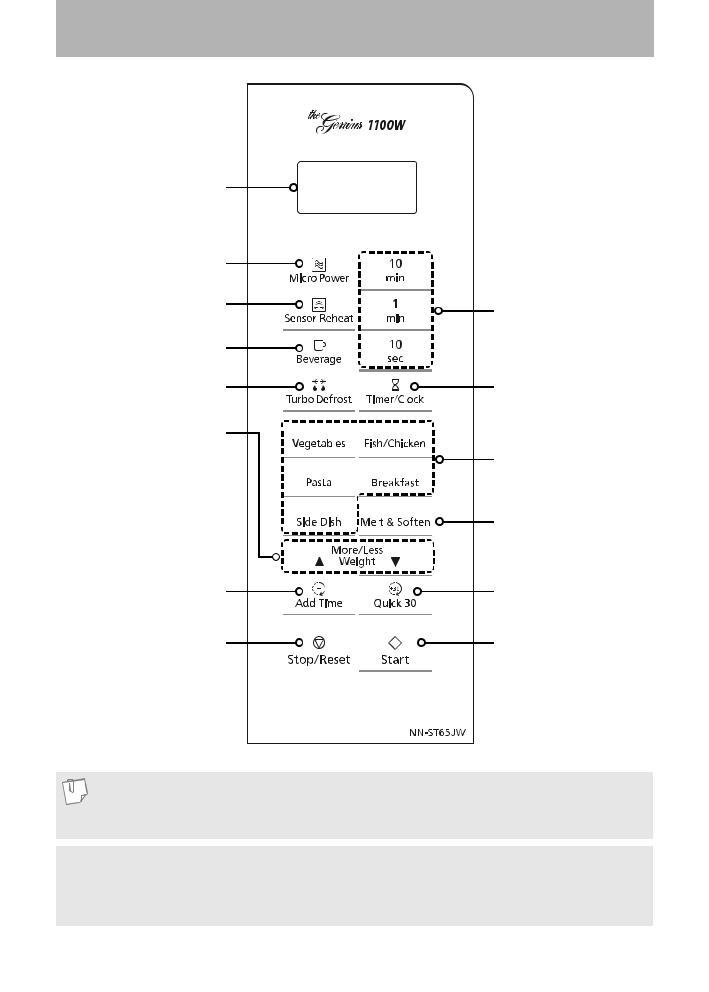
Control Panel
|
|
|
|
|
|
|
|
|
|
|
|
|
|
|
|
* The control panel of |
|
|
|
|
|
|
|
|
|
|
|
|
|
|
|
|
|
|
|
|
|
|
|
|
|
|
|
|
|
|
|
|
|
|
|
|
|
|
|
|
|
|
|
|
|
|
|
|
|
|
|
|
|
|
|
|
|
|
|
|
|
|
|
|
|
|
|
|
|
|
|
|
|
|
|
|
|
|
|
|
|
|
|
|
NN-ST65JW/NN-ST67JS/ |
|
|
|
|
|
|
|
|
|
|
|
|
|
|
|
|
NN-ST69JS have the same |
Display Window |
|
|
|
|
|
|
|
key layout. |
||||||||
(Pg. 13) |
|
|
|
|
|
|
|
|
||||||||
Micro Power Pad |
|
|
|
|
|
|
|
|
||||||||
(Pg. 15-16) |
|
|
|
|
|
|
|
|
|
|
||||||
Sensor Reheat Pad |
|
|
|
|
|
|
|
Time Pads |
||||||||
(Pg. 19) |
|
|
|
|
|
|
|
|
|
|||||||
|
|
|
|
|
|
|
|
|||||||||
Beverage Pad |
|
|
|
|
|
|
|
|
||||||||
(Pg. 20) |
|
|
|
|
|
|
|
|
|
|
||||||
Turbo Defrost Pad |
|
|
|
|
|
|
|
Timer/Clock Pad |
||||||||
(Pg. 16) |
|
|
|
|
|
|
|
|
|
(Pg. 14, 27) |
||||||
|
|
|
|
|
|
|
||||||||||
More/Less/Weight Pads |
|
|
|
|
|
|
|
|
||||||||
(Pg. 16, 20, 25) |
|
|
|
|
|
|
|
|
|
|
Sensor Cook Pads |
|||||
|
|
|
|
|
|
|
|
|||||||||
More/Less setting: |
|
|
|
|
|
|
|
|
|
|
|
|
|
|
|
|
To adjust the cooking time for |
|
|
|
|
|
|
|
(Pg. 21-24) |
||||||||
Auto/Sensor programs. |
|
|
|
|
|
|
|
|
|
|
|
|
|
|
|
|
Weight setting: |
|
|
|
|
|
|
|
Melt & Soften Pad |
||||||||
To select the serving/weight for |
|
|
|
|
|
|
|
|||||||||
|
|
|
|
|
|
|
||||||||||
|
|
|
|
|
|
|
||||||||||
Turbo Defrost feature and Auto |
|
|
|
|
|
|
|
|
|
|
|
|
|
|
|
(Pg. 25) |
|
|
|
|
|
|
|
|
|
|
|
|
|
|
|||
programs. |
|
|
|
|
|
|
|
|
||||||||
|
|
|
|
|
|
|
|
|
|
|
|
|
|
|
|
|
Add Time Pad |
|
|
|
|
|
|
|
Quick 30 Pad |
||||||||
(Pg. 18) |
|
|
|
|
|
|
|
|
|
(Pg. 18) |
||||||
Stop/Reset Pad |
|
|
|
|
|
|
|
Start Pad |
||||||||
|
|
|
|
|
|
|
||||||||||
|
|
|
|
|
|
|
||||||||||
Before cooking: One press |
|
|
|
|
|
|
|
One press allows oven to |
||||||||
clears all your instructions. |
|
|
|
|
|
|
|
|
|
|
|
|
|
|
|
begin functioning. If door is |
|
|
|
|
|
|
|
|
|
|
|
|
|
|
|||
During cooking: One press |
|
|
|
|
|
|
|
opened or Stop/Reset pad |
||||||||
temporarily stops the cooking |
|
|
|
|
|
|
|
is pressed once during oven |
||||||||
process. Another press cancels |
|
|
|
|
|
|
|
operation, Start pad must |
||||||||
all your instructions and colon |
|
|
|
|
|
|
|
again be pressed to restart |
||||||||
or time of day appears in the |
|
|
|
|
|
|
|
oven. |
||||||||
display window. |
|
|
|
|
|
|
|
|
||||||||
Note
If an operation is set and Start Pad is not pressed, after 6 minutes, the oven will automatically cancel the operation. The display will revert back to clock or colon mode.
Beep Sound
When a pad is pressed correctly, a beep sound will be heard. If a pad is pressed and no beep is heard, the unit does not or cannot accept the instruction. The oven will beep twice between programmed stages. At the end of any complete programme, the oven will beep five times.
– 12 –
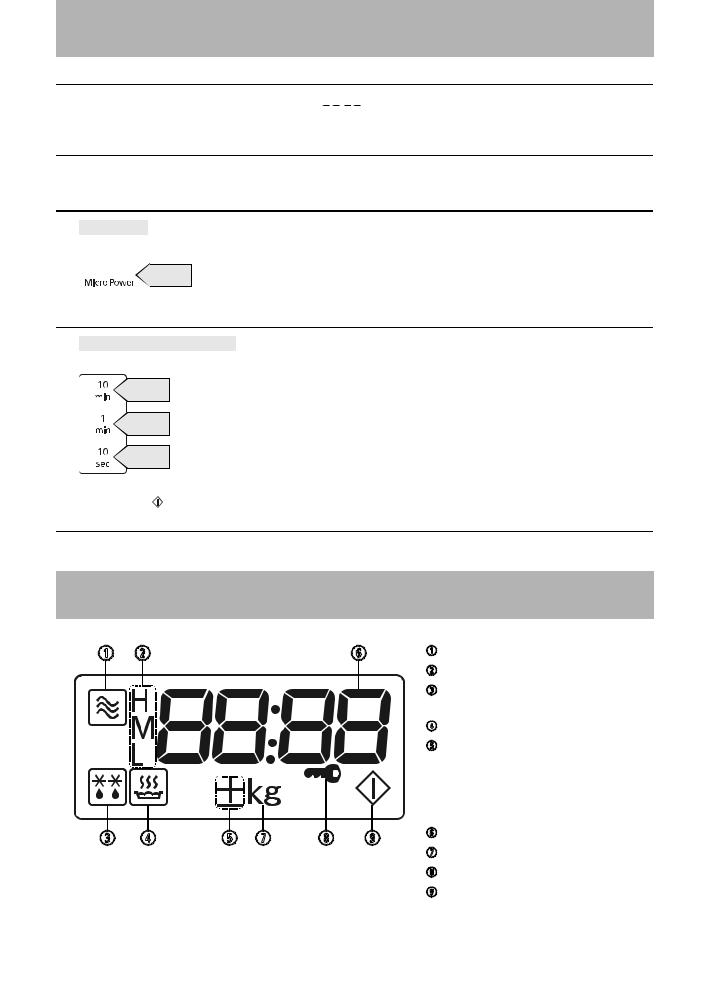
Let’s Start To Use Your Oven!
1 Plug in.
Plug into a properly earthed electrical outlet. “



 ” appears in the display window, then you can start to operate.
” appears in the display window, then you can start to operate.
2 Open Door.
Open the door and place container with food in a dish on Glass Tray in the oven. Then close the door.
3 Select Power Level.
e.g. 440 W
Press Micro Power pad 4 times (see page 15 for Micro Power chart).  4 times
4 times
4 Set Time.
e.g. 12 minute 20 seconds
Press Time pads.
once twice twice
5 Press  .
.
Cooking will start. The time in the display window will count down.
Display Window
|
|
Micro Power FeaturePower Level Display
Turbo Defrost Feature/ Defrost Display
Auto Cook Feature
More/Less Feature
Press More Pad (  ):
):
“+” will appears in the display window.
Press Less Pad (  ):
):
“-” will appears in the display window.
Number (Time/Weight/Menu)
Weight Display (g/kg)
Child Safety Lock Display
Start Display
– 13 –
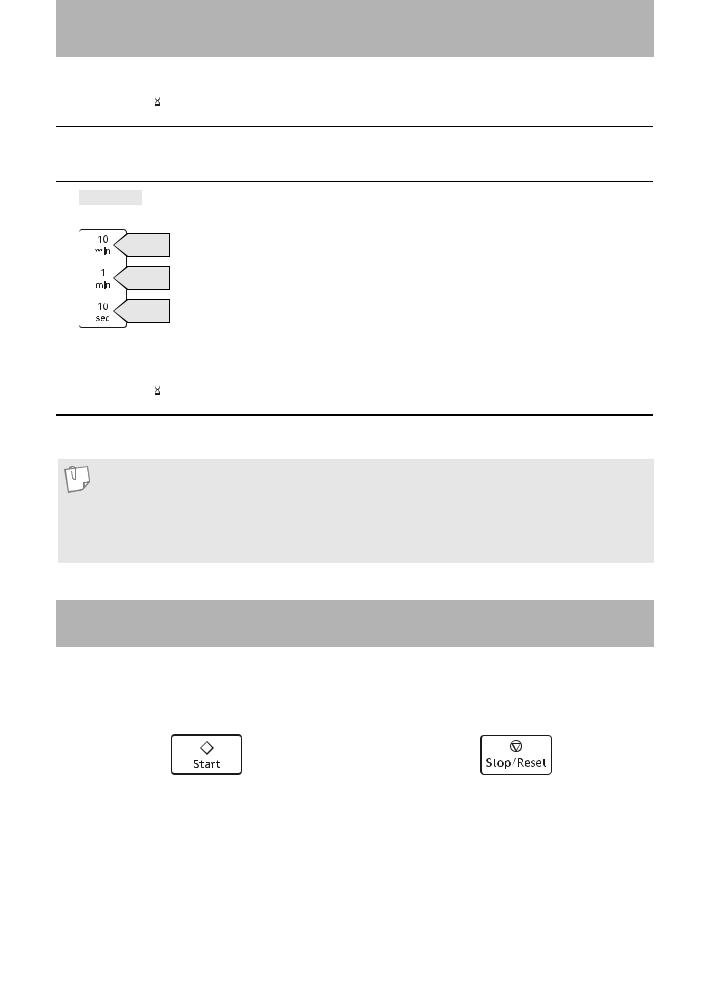
To Set Clock
You can use the oven without setting the clock.
1 Press  Twice.
Twice.
Colon will blink in the display window.
2 Enter Time of Day.
e.g. 12:35
Enter time of day using Time Pads.
12 times
3 times
5 times
Time appears in the display window, colon is blinking.
Verify time of day in the display window.
3 Press  .
.
Colon stops blinking; time of day is entered and locked in the display window.
Note
1.To reset time of day, repeat steps 1-3.
2.The clock will keep the time of day as long as oven is plugged in and electricity is supplied.
3.Clock is a 12-hour display.
4.Oven will not operate while colon is blinking.
To Use Child Safety Lock
This feature allows you to prevent operation of the oven by a young child; however, the door will open.
This feature can be set when colon or time of day is displayed.
To set: |
To cancel: |
|
|
|
|
Press Start 3 times.
Colon or time of day will disappear. Actual time will not be lost.
" " appears in the display window.
" appears in the display window.
Press Stop/Reset 3 times.
Colon or time of day will reappear in the display window.
To set or cancel child safety lock, Start pad or Stop/Reset pad must be pressed 3 times within 10 seconds.
– 14 –
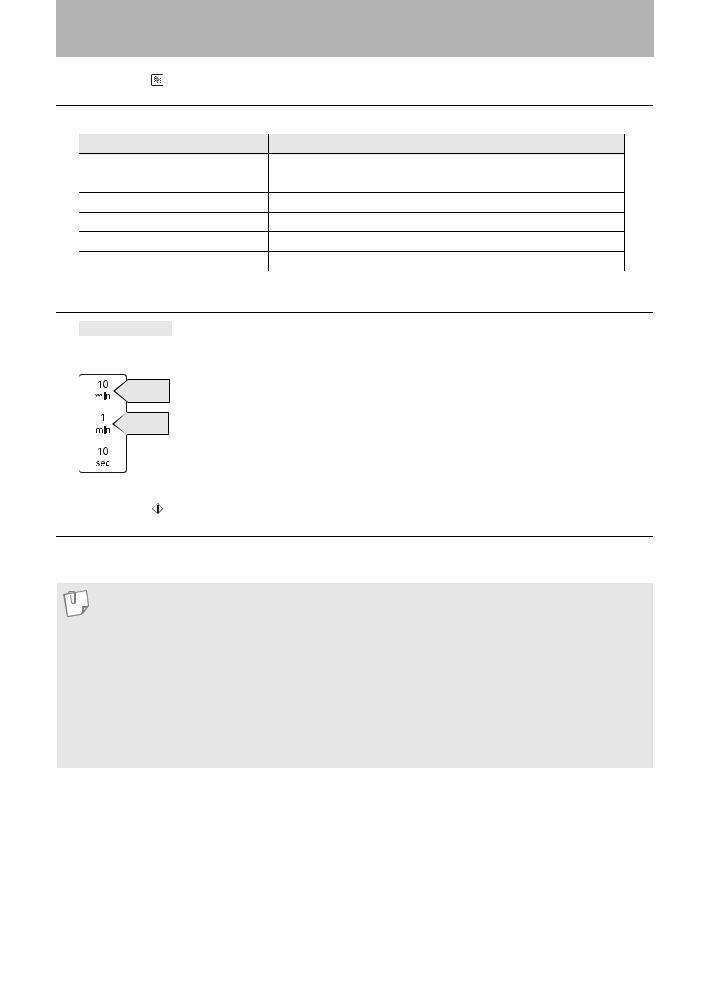
To Cook on Micro Power by Time Setting
1 Press  to Select Micro Power Level.
to Select Micro Power Level.
Press Micro Power pad until your desired power level appears in the display window. (see chart below)
Press |
Power Level |
Example Of Use |
once |
1100 W (HIGH) |
Boil water. Reheat. Cook vegetables, rice, pasta and noodles. |
twice |
800 W (MED-HIGH) |
Cook poultry, meat, cakes, desserts. Heat milk. |
3 times |
600 W (MEDIUM) |
Cook beef, lamb, eggs, fish and seafood. Melt butter. |
4 times |
440 W (MED-LOW) |
Simmer soups, stews and casseroles (less tender cuts). |
5 times |
300 W (DEFROST) |
Thaw foods. |
6 times |
100 W (LOW) |
Keep cooked foods warm, simmer slowly. |
2 Set Cooking Time.
e.g. 15 minutes
Enter cooking time by using Time pads.
1100 W: up to 30 minutes, Other Powers: up to 99 minutes 50 seconds.
once
5 times
3 Press  .
.
Cooking will start.
The time in the display window will count down.
Note
1. It is possible to programme no more than 3 stages cooking as one cooking set. For 2 or 3 stages cooking, repeat steps 1 and 2 above before pressing Start pad. When operating, two beeps will be heard between each stage. (Please refer to page 26 for details).
2.You can increase the cooking time during cooking if required. Time can be increased in 1 minute increments, up to 10 minutes. Press Add Time pad once, then press 1 min pad to a maximum of 10 minutes. After selecting add time function, time should be added within a 5 second period. Cooking time can not be decreased during cooking.
3.Do not use metal containers on microwave mode.
4.Standing time can be programmed after Micro Power and time setting. Refer to using the timer page 27.
– 15 –
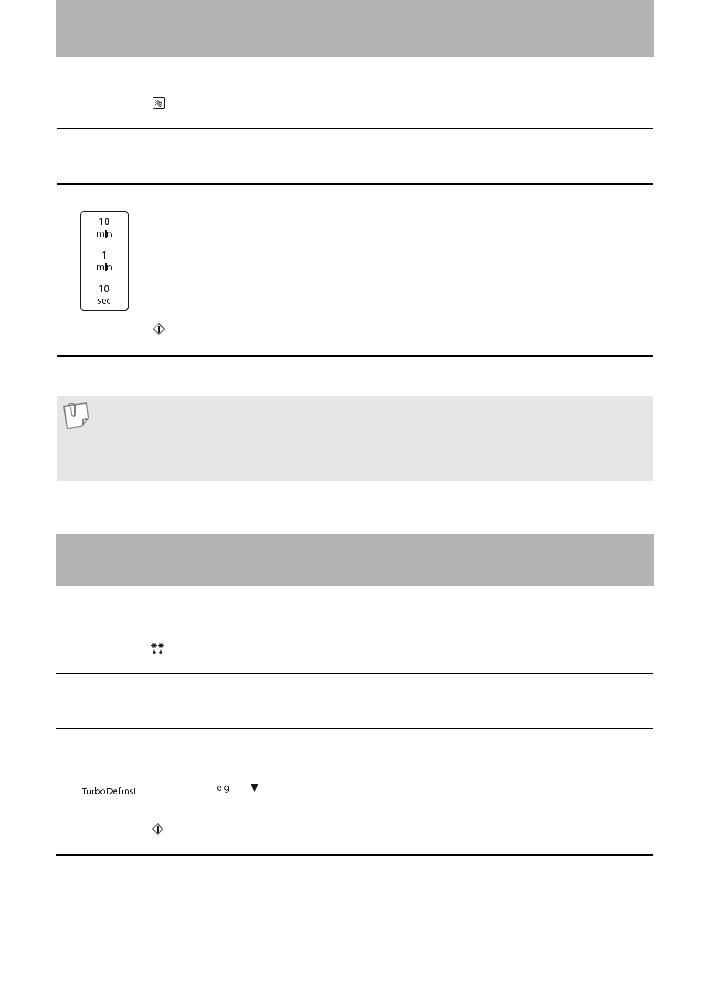
To Defrost on Micro Power by Time Setting
This feature allows you to defrost meat, poultry and seafood by 300 W and time.
1 Press  .
.
Press 5 times to select 300 W. (Defrost power level, refer to page 15)
2 Set Defrosting Time.
Set defrosting time by using Time pads. (up to 1 hour and 30 minutes)
3 Press  .
.
Defrost time appears in the display window and begins to count down.
Note
1.Opening the door and taking out the defrosted parts during the operating time is recommended. turn over, stir or rearrange the parts which are still in icy.
2.For manual defrosting times, please refer to defrosting chart on page 28.
To Defrost Using Turbo Defrost
This feature allows you to defrost meat, poultry and seafood automatically by just setting the weight. The serving/weight is 0.1 kg to 3.0 kg.
1 Press  .
.
Press once to select Turbo Defrost feature.
2 Select Desired Weight.
Pressing Turbo Defrost pad or More/Less/Weight pads until your desired weight appears in the display window.
 or
or 
3 Press  .
.
Press Start. Defrosting time appears in the display window and begins to count down.
– 16 –
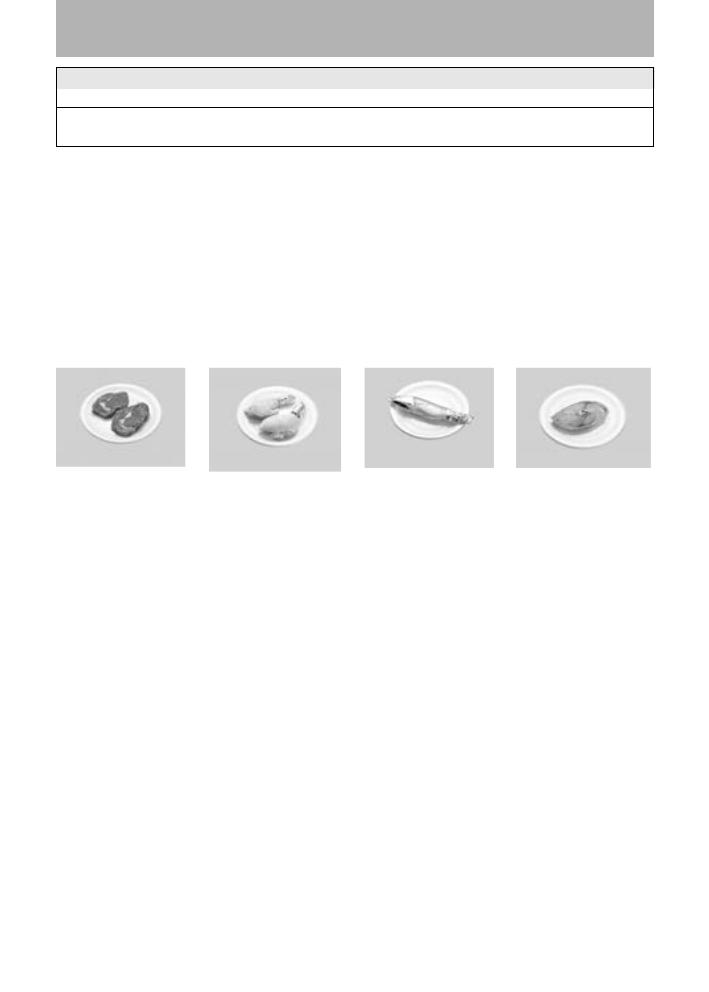
To Defrost Using Turbo Defrost (continued)
Food |
Maximum Weight |
Minced meat, chicken pieces, chops |
3 kg |
Beef roast, lamb, whole chickens |
3 kg |
Whole fish, scallops, prawns, fish fillets |
1 kg |
Tips for Turbo defrost
Meat, which is with bones. For example, if the meat with bones has the same weight as the pure meat, the meat in the former one is lighter than the latter one. So, subtract 0.5 kg for 2 kg meat with bones is better for defrosting and 0.25 kg for meat with bones which is less than 2 kg.
Two buzz beeps
Turn over the meat, chicken, fish and shellfish. Separate the stewed meat, chicken pieces and meat loaf. Apart the meat loaf from the hamburger. Shield the edge of chicken wings, roast, fat or bones.
Key to defrosting |
For evenly defrosting, turn over the foods or move the position of the foods in the |
|
containers during the progress of defrosting. |
Remove the package of |
Shield the front part of |
the raw meat and place |
the chicken drumsticks |
it on the plate. |
by using aluminum foil. |
Shield the head and tail of the whole fish by using aluminum foil.
Remove the package of the fish fillet and place it on the plate.
– 17 –
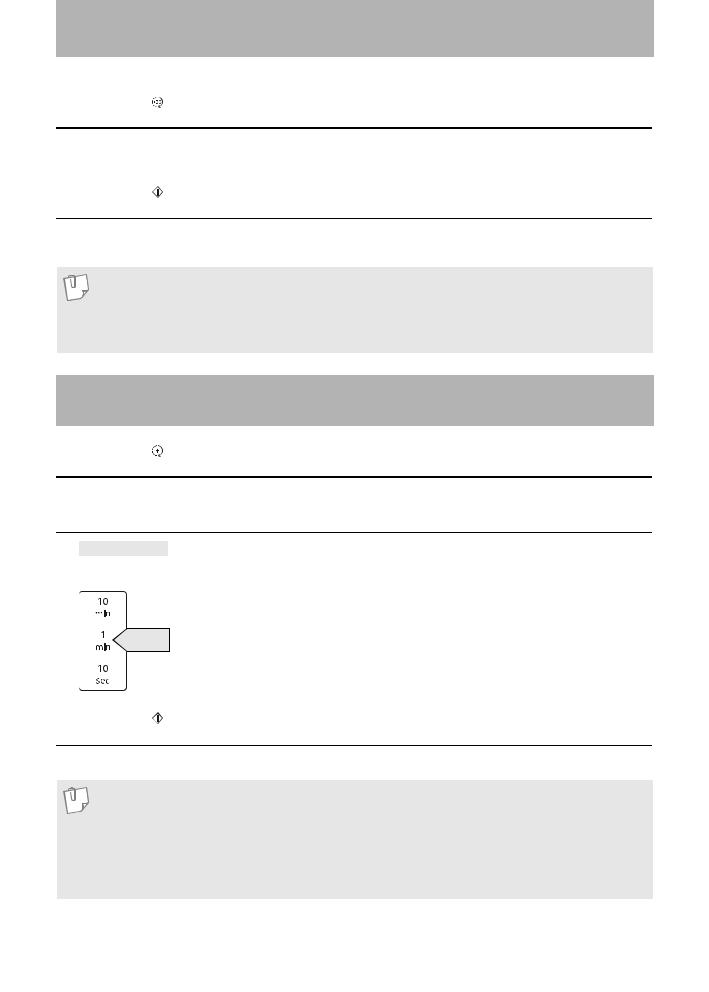
To Cook Using the Quick 30 Feature
This feature allows you to quickly set cooking time in 30 second increments.
1 Press  .
.
Press Quick 30 to set the desired cooking time (up to 5 minutes). Each press is 30 seconds. Time appears in the display. Power level is pre-set at 1100 W.
2 Press  .
.
The cooking will start and the time in the display will count down. At the end of cooking, five beeps will sound.
Note
1.This feature is only available for Micro Power mode. Select desired micro power level before pressing Quick 30.
2.After setting the time by Quick 30, you cannot use Time pads.
Using the Add Time Feature
1 Press  .
.
After cooking, press Add Time pad once to select the Add Time feature.
2 Enter Cooking Time.
e.g. 5 minutes
Enter cooking time by using Time pads.
1100 W: up to 30 minutes, Other powers: up to 99 minutes and 50 seconds.
5 times
3 Press  .
.
Time will be added. The time in the display window will count down.
Note
1.This feature is not available for Turbo Defrost, Beverage, Melt & Soften, Sensor Reheat and Sensor Cook menus.
2.The Add Time feature will not operate after 1 minute cooking.
3.The Add Time feature can be used after the 3-stage cooking.
4.The power level is the same as the last stage.
–18 –

To Use Sensor Reheat Feature
This feature allows you to reheat foods without selecting times and power levels. The sensor detects the heat and humidity generated by the food and reheat your food automatically.
1Press  .
.
2Press  .
.
After the heat and humidity is detected by the SENSOR, the remaining time appears in the display window and begins to count down.
Note
1. If desired, press More/Less/Weight pads to adjust the cooking time before pressing Start.
2.Reheating by Sensor is suitable for pre-cooked foods. There is a setting for frozen and refrigerator temperature or room temperature foods. It is suitable for casseroles, plated meals, soup, stews, pasta dishes (except lasagne) and canned foods. Food being reheated should weigh between 125 g and 1.0 kg. For foods weighing less than 125 g and more than 1.0 kg, use a manual micro power setting.
3.Do not reheat bread or pastry products (raw or uncooked), or beverages.
4.Do not use if oven cavity is warm (from previously cooked foods).
5.Cover foods securely with plastic wrap. (Do not use any snap closing lids.)
6.The door should not be opened before the time appears in the display window.
7.During the heating time, the oven will ‘beep’ and prompt you to stir/rearrange the food. There is no need to recover if not required.
8.All foods should have a covered standing time of at least 3 to 5 minutes.
– 19 –

To Use Beverage Feature
1 Press  .
.
Press Beverage pad until the desired menu appears in the display window (see chart below).
Menu No. |
Menu |
Serving/Weight |
Recommended containers |
||
1 |
Coffee |
1-1 (1 cup coffee) |
1-2 (2 cups coffee) |
Microwave safe cup |
|
2 |
Milk |
2-1 (1 cup milk) |
2-2 (2 cups milk) |
||
|
|||||
2 Select the Serving/weight.
Select the Serving/Weight by using the More/Less/Weight pads.
3 Press  .
.
Reheat will start. The time in the display window will count down.
Note
1. Use a microwave safe cup. Heated coffee/milk can erupt if not mixed with air. Do not heat coffee/ milk in your microwave oven without stirring before and halfway through heating.
2.Care must be exercised not to overheat coffee/milk when using the Beverage feature. It is programmed to give proper result when heating 1 cup or 2 cups of coffee/milk, starting from room temperature for coffee and refrigerator temperature for milk. Overheating will cause an increased risk of scalding, or water eruption.
3.1 cup of milk is 200 ml to 250 ml and 1 cup of coffee is 150 ml to 200 ml.
– 20 –

To Use Sensor Cook Menus
This feature allows you to cook foods without selecting time and power level. Only set desired menu number and Serving/Weight, the oven will cook your food automatically.
1 Press Desired Food Category Pad.
Select and press the desired food category pad. Menu number will appears in the display window. e.g. Vegetable pad
Press once for Vegetables.




 Press twice for Root Vegetables
Press twice for Root Vegetables
2 Press  .
.
The time in the display window will count down.
Press 
Menu No. |
Menu |
Recommended Weight |
Recommended containers |
3 |
Vegetables |
125 g - 500 g |
|
4 |
Root Vegetables |
125 g - 1 kg |
Microwave safe casserole with lid or plastic wrap |
5 |
Frozen Vegetables |
125 g - 1 kg |
|
Press 
Menu No. |
Menu |
Recommended Weight |
Recommended containers |
6 |
Fish |
125 g - 500 g |
Microwave safe plate with plastic wrap |
7 |
Chicken Pieces |
400 g - 1 kg |
Microwave safe casserole with lid or plastic wrap |
Press 
Menu No. |
Menu |
Recommended Weight |
Recommended containers |
|
8 |
Dried Pasta |
150 g - 500 g |
Microwave casserole with lid |
|
9 |
Instant Noodles |
1 serv.-2 servs. |
||
|
Press 
Menu No. |
Menu |
Recommended Weight |
Recommended containers |
|
10 |
Porridge |
100 g - 300 g |
Microwave casserole with lid |
|
11 |
Scrambled Egg |
50 g - 200 g |
||
|
– 21 –
